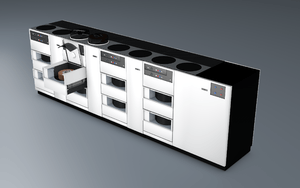IBM System/370 Model 165
The IBM System/370 Model 165 (and the Model 155[2]) were jointly announced June 30, 1970[3] as "designed for ... the Seventies." That same day IBM announced the 370/195.[4] They were the first three models of the IBM System/370 line of computers.
 | |
| Manufacturer | International Business Machines Corporation (IBM) |
|---|---|
| Product family | System/370 |
| Release date | June 30, 1970 |
| Discontinued | December 23, 1977 |
| Website | Official website IBM Archives |

Direct Access Storage Facility,
code-named Merlin, was introduced in June 1970 for use with the IBM System/370. Its removable disk packs could hold 100 MB
Three months later a fourth IBM System/370, the Model 145, was announced. Since none of them came with virtual memory, "which was to be a hallmark of the 370 line"[5] some said about these early members of the IBM System/370 family, especially about the 165 & 155, that they were not "the real 370 line."[NB 1]
Growth path
The initially announced System/370 Models 165 & 155 systems were in many ways merely improved IBM System/360 systems.
- Both were announced[3] to "run under proven OS programming support." (meaning the non-virtual memory MFT or MVT Operating systems)[NB 2]
- As compared to the 360, their basic architecture was described as "extended, but not redesigned, for System/370.
- The IBM System/360 Model 85 used microcode to control instruction execution,[6] unlike the completely-hardwired 360/75 and 360/91; the high-end models of System/370 were also microcoded. Some describe the 360/85 as a bridge to the 370/165.[7]
Upgrade option
In 1972 an upgrade option was announced "to provide the hardware necessary to operate in a virtual memory mode."[8]
Unlike the IBM System/370 Model 145, which as early as June 1971 could have virtual memory capability added to it with a simple microcode update from a floppy disk, the Model 155 and Model 165 needed expensive hardware additions - $200,000 for the 155 and $400,000 for the 165 - to add virtual memory capability, and even this had to wait until 1972. An upgraded 165 was known as an IBM System/370 Model 165-II.[9]
Emulation
The 370/165, when equipped with the appropriate compatibility feature,[10][11][12]with the use of an emulator program permits running
- 7070, 7072 and 7074 programs[13]
- IBM 7080 programs[14]
- 709, 7040, 7044, 7094 and 7094 II programs.[15]
The IBM 7070/7074 Compatibility Feature allowed the 165 to "run 7070 and 7074 programs at speeds that, in general, equal or exceed those of the original systems"[10] and yet "not affect normal operation of System/370."[10]:p.5
Physical memory
Although the joint 155/165 announcement[3] did not have the word virtual, there were multiple references to (physical) memory, storage (both main memory and disk storage), and cache memory under the name "buffer".
The 155 had seven main memory choices, ranging from 256K to 2 MB; the 165: five possibilities, from 512K to 3 MB. Both models were described as having "a very high-performance buffer storage backed by a large" main memory.
Notes
- The 195 was noted as "at the time of its introduction, ... IBM's most powerful computing system" and the 145's microcode could be upgraded from a floppy disk. By contrast, the 155 & 165 needed a hardware addition priced at $200,000 and $400,000 respectively
- The Model 155 was also enabled to "run under DOS support."
References
- "System/370 Model 145". IBM Archives. IBM.
- "System/370 Model 155". IBM Archives. IBM.
- "System/370 Model 165". IBM Archives. IBM.
- coming about 14 months after the announcement of the 360/195. Both 195 machines were withdrawn Feb. 9, 1977. see https://www-03.ibm.com/ibm/history/exhibits/mainframe/mainframe_PP2195.html and https://www-03.ibm.com/ibm/history/exhibits/mainframe/mainframe_PP3195.html
- "What Course for the 3081?". Computerworld. November 24, 1980. p. 34.
- Robert L. Asenhurst. Foundations of Microprogramming. p. 34. ISBN 1483215873.
- Jon Elson (December 5, 2014). "IBM 360/85 vs. 370/165". Newsgroup: alt.folklore.computers.
- "First IBM DAT Box Installed". Computerworld. August 15, 1973. p. 17.
- A. Padegs (September 1981). "System/360 and Beyond". IBM Journal of Research & Development. IBM. 25 (5): 377–390. doi:10.1147/rd.255.0377. – tables include model characteristics (Table 1) and announcement/shipment dates (Table 2). The S/370-155-II and -165-II are listed under the former but not the latter, because the upgraded systems were not formally announced as separate models. The "System/370 Advanced Function" announcement, including the -158 and -168, was the main public event.
- 7070/7074 Compatibility Feature for IBM System/370 Models 165, 165 II, and 168 (PDF) (Second ed.), IBM, June 1973, GA22-6958-1
- IBM System/370 Special Feature Description 7080 Compatibility Feature for IBM System/370 Model 165, First Edition, IBM, July 1971, GA22-6963-0
- IBM System/370 Special Feature Description 709/7090/7094 Compatibility Feature for IBM System/370 Model 165, First Edition, IBM, November 1970, GA22-6955-0
- IBM (February 1971), Emulating the IBM 7074 on the IBM System/370 Models 155 and 165 using OS/360 Program Number 360C-EU-739, Second Edition, GC27-6948-1
- IBM (August 1971), Systems Logic Program to Emulate the IBM 7080 on the IBM System/370 Model 165 using OS/360 Program Number 360C-EU-737 OS Release 20, First Edition, GY27-7229-0
- Emulating the IBM 7094 on the IBM Models 85 and 165 using OS/360 Program Number for M/85: 360C-EU-734 Program Number for M/165: 360C-EU-740 OS Release 20 (Third ed.), IBM, November 1971, GC27-6951-2
.jpg)